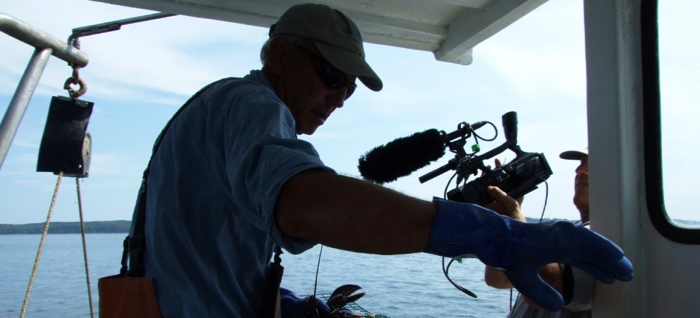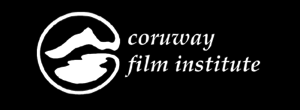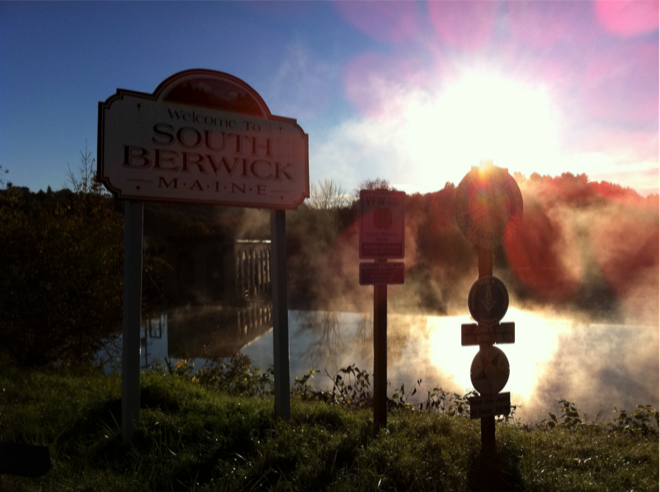
why
from Executive Director, William Rogers
Coruway Film Institute brings significant media work to the public and supports the creation of this work. But that's not just in creating the films themselves, but in the cultivation of a climate where works can be seen and known. Coruway is a collection of artists creating work that celebrates the human spirit, work that makes us collectively richer.
We help create media and we help such work be seen and heard. We love the tools that are available to all of us.
From the beginning we have been dedicated to amplifying the voice and magnifying the image of those on society's edges.
Coruway was formed in 1989 as a non-profit organization in the state of New Hampshire. We received recognition by the IRS as a 501(c)(3) charitable organization.
Our name comes from a mountain in New Hampshire's White Mountains, today called Mount Chocorua, but formerly known as Coruway.
Coruway Film Institute brings significant media work to the public and supports the creation of this work. But that's not just in creating the films themselves, but in the cultivation of a climate where works can be seen and known. Coruway is a collection of artists creating work that celebrates the human spirit, work that makes us collectively richer.
We help create media and we help such work be seen and heard. We love the tools that are available to all of us.
From the beginning we have been dedicated to amplifying the voice and magnifying the image of those on society's edges.
Coruway was formed in 1989 as a non-profit organization in the state of New Hampshire. We received recognition by the IRS as a 501(c)(3) charitable organization.
Our name comes from a mountain in New Hampshire's White Mountains, today called Mount Chocorua, but formerly known as Coruway.

When the organization was formed we were adapting a novel, LOOK TO THE MOUNTAIN, into a screenplay. In the story a young couple move from settled area in the south of New Hampshire around the time of the American Revolution to the wilderness of the north. As the central character, Whit, is looking for a place to homestead he gets lost and climbs a tree to get oriented. Clouds are everywhere, nothing is familiar. But then the clouds break enough for the peak of the mountain to reveal itself above the clouds. Whit knows that he has found his spot there on the side of the Mountain. The moment when the clouds open to see the mountain is Whit's moment of arrival. He is in the right place, right time.
For me, my "homesteading" has been in the world of images and sounds. I'm looking for my sense of place and my relationship to the world about me by spinning stories together, by looking around me. We all have a place and a mission. My own mission is to find my own place as I look at those around me and see what sense they have made of the world in which they live.
In addition to the adaptation of LOOK TO THE MOUNTAIN one of our early projects was a documentary film about my uncle, Joe Rogers. He was diagnosed as a boy as mildly mentally retarded and institutionalized as a teenager. While the original plan when Joe was a boy may have been for his return home after some education and training, it was clear after some years that he would spend the rest of his days at the institution. When I was growing up I would see my Uncle Joe on weekends and holidays. And there was such a huge disparity between the place he lived – the institution – and his passionate view of his world.
My Uncle could sing and play the blues like nobody else. He would entertain himself and anybody who wanted to listen for hours at the piano. And he told stories about the people in his life as if he were a retired farmer on a river delta.
Joe got out of the institution and the film follows him in his journey back to the community. We sought, with our film , to amplify his voice and magnify his image so that people would know his story. MY UNCLE JOE was our first completed project and was finished in 1992, nominated for an Emmy, received festival play – like a Blue ribbon American Film/ Video Festival, Outstanding Video at the New England Film & VIdeo Festival – and has been used by organization assisting people with disabilities across the country. The show also received media awards from TASH (for Persons with Severe Handicap) and the Arc of Massachusetts.
Most important to me was that the film brought an audience into both Joe's world and how he saw it. It is not only about his life – what happened to him – but how he sees his life and world. Joe's story is a testament to Tarkowski's – a late Soviet-era Russian filmmaker and film theorist – notion that the image is the gateway to the spiritual.
So why form a non-profit organization to make films like My Uncle Joe? I believe a film like it would not be made without some form of public contribution. And the film's measure of success is not merely profitability. Coruway was established not only for the creation of such a film, but also set to establish the sustainability of such films. The film needs to be made and seen. And go to benefit those who may use it.
The niche is our niche. Which is another way to state that we bring the edge to the public and the public to the edge. The edges define the center, and many culturally worthwhile movements or perspectives came from the fringe.
But it is a tricky thing, being out of the mainstream. By being off the main path it often means that there are fewer fellow travelers. These days the buzz-word is market share = popularity = money. Of course, I'm mixing audience with creators, but there is an important relationship between the climate of creation and the climate of distribution. Because the viewer, to me, is not a passive recipient, but is an active fellow traveler. That is becoming more and more true as the web allows audience to find the work, instead of the work being sent via traditional distribution channels.
And there's another difficult subject here and that is the idea of measuring excellence. How do we know when we've found something good? How do we know when we've made something good? And how do we approach creating something good? In a ski race, the clock determines better and worse. Fastest wins, and most hold winning good. But what if you lose 80% of the time only to win in the minority? Well, if you're Bode Miller that minority of wins can be extraordinary if the wins happen at the right time. Or, the "losses" can hold such promise they set the stage for later wins. In a similar sense the creative problem-solving of a person defined as mentally-retarded can redefine how a "normal" person looks at their world.
We observe and thus participate in stories and get those stories to the public. We are involved in the process of bringing those stories forward. We not only write screenplays but we hold workshops and lead seminars on the topic. This is all part of creating the climate in which and with which are work can get better.
Since 1992 when the film My Uncle Joe was released we have led many educational programs, primarily in New England, including media workshops with grade student in Massachusetts under the title "The Truth About Smoking." Students created :30 second spots as they interviewed one another about the truths they saw about smoking. We also worked with NH Works to present the work opportunities in industry around New Hampshire. We worked with the NH Governor's Office to create a video for Kids Cabinet, a program designed to bring quality after-school programs to all of NH school-age children. We've helped vital programs raise funds for themselves as they have informed the public of their missions (Stepping Stones, Futures, PlusTime NH, The Great Bog...).
But we've spent the most accumulated hours with a number of long-format documentaries, two funded by the Corporation for Public Broadcasting through Independent Television Service (ITVS) and one with independent finances. We provided provided production and post-production support for LIVABLE LANDSCAPES (Cross Current Productions in partnership with NH's CHannel 11 & the NH Forestry Society), a film that looked on the effect of population growth and sprawl in northern New England.
We also produced a film in partnership with ITVS and WGBH, Boston about America's first institution for the mentally retarded, Fernald State School. It's the history of the place, but also looks at how places become containers for our notions of people, and how those notions change through time. Behind the walls, however, humanity looks out at us and asks who we are and what is the meaning of a place like Fernald?
For me, my "homesteading" has been in the world of images and sounds. I'm looking for my sense of place and my relationship to the world about me by spinning stories together, by looking around me. We all have a place and a mission. My own mission is to find my own place as I look at those around me and see what sense they have made of the world in which they live.
In addition to the adaptation of LOOK TO THE MOUNTAIN one of our early projects was a documentary film about my uncle, Joe Rogers. He was diagnosed as a boy as mildly mentally retarded and institutionalized as a teenager. While the original plan when Joe was a boy may have been for his return home after some education and training, it was clear after some years that he would spend the rest of his days at the institution. When I was growing up I would see my Uncle Joe on weekends and holidays. And there was such a huge disparity between the place he lived – the institution – and his passionate view of his world.
My Uncle could sing and play the blues like nobody else. He would entertain himself and anybody who wanted to listen for hours at the piano. And he told stories about the people in his life as if he were a retired farmer on a river delta.
Joe got out of the institution and the film follows him in his journey back to the community. We sought, with our film , to amplify his voice and magnify his image so that people would know his story. MY UNCLE JOE was our first completed project and was finished in 1992, nominated for an Emmy, received festival play – like a Blue ribbon American Film/ Video Festival, Outstanding Video at the New England Film & VIdeo Festival – and has been used by organization assisting people with disabilities across the country. The show also received media awards from TASH (for Persons with Severe Handicap) and the Arc of Massachusetts.
Most important to me was that the film brought an audience into both Joe's world and how he saw it. It is not only about his life – what happened to him – but how he sees his life and world. Joe's story is a testament to Tarkowski's – a late Soviet-era Russian filmmaker and film theorist – notion that the image is the gateway to the spiritual.
So why form a non-profit organization to make films like My Uncle Joe? I believe a film like it would not be made without some form of public contribution. And the film's measure of success is not merely profitability. Coruway was established not only for the creation of such a film, but also set to establish the sustainability of such films. The film needs to be made and seen. And go to benefit those who may use it.
The niche is our niche. Which is another way to state that we bring the edge to the public and the public to the edge. The edges define the center, and many culturally worthwhile movements or perspectives came from the fringe.
But it is a tricky thing, being out of the mainstream. By being off the main path it often means that there are fewer fellow travelers. These days the buzz-word is market share = popularity = money. Of course, I'm mixing audience with creators, but there is an important relationship between the climate of creation and the climate of distribution. Because the viewer, to me, is not a passive recipient, but is an active fellow traveler. That is becoming more and more true as the web allows audience to find the work, instead of the work being sent via traditional distribution channels.
And there's another difficult subject here and that is the idea of measuring excellence. How do we know when we've found something good? How do we know when we've made something good? And how do we approach creating something good? In a ski race, the clock determines better and worse. Fastest wins, and most hold winning good. But what if you lose 80% of the time only to win in the minority? Well, if you're Bode Miller that minority of wins can be extraordinary if the wins happen at the right time. Or, the "losses" can hold such promise they set the stage for later wins. In a similar sense the creative problem-solving of a person defined as mentally-retarded can redefine how a "normal" person looks at their world.
We observe and thus participate in stories and get those stories to the public. We are involved in the process of bringing those stories forward. We not only write screenplays but we hold workshops and lead seminars on the topic. This is all part of creating the climate in which and with which are work can get better.
Since 1992 when the film My Uncle Joe was released we have led many educational programs, primarily in New England, including media workshops with grade student in Massachusetts under the title "The Truth About Smoking." Students created :30 second spots as they interviewed one another about the truths they saw about smoking. We also worked with NH Works to present the work opportunities in industry around New Hampshire. We worked with the NH Governor's Office to create a video for Kids Cabinet, a program designed to bring quality after-school programs to all of NH school-age children. We've helped vital programs raise funds for themselves as they have informed the public of their missions (Stepping Stones, Futures, PlusTime NH, The Great Bog...).
But we've spent the most accumulated hours with a number of long-format documentaries, two funded by the Corporation for Public Broadcasting through Independent Television Service (ITVS) and one with independent finances. We provided provided production and post-production support for LIVABLE LANDSCAPES (Cross Current Productions in partnership with NH's CHannel 11 & the NH Forestry Society), a film that looked on the effect of population growth and sprawl in northern New England.
We also produced a film in partnership with ITVS and WGBH, Boston about America's first institution for the mentally retarded, Fernald State School. It's the history of the place, but also looks at how places become containers for our notions of people, and how those notions change through time. Behind the walls, however, humanity looks out at us and asks who we are and what is the meaning of a place like Fernald?
We also support – via being their fiscal agent – a program about individuals with disabilities photographing themselves and their environment. The documentary is by Courtney Bent and George Kachadorian called SHOOTING BEAUTY.
Another major project is ten years in the life of a ski racer. Just after the 1998 Winter Olympics in Japan I asked Bode Miller, a young, talented, but seemingly reckless skier if I could follow him to the 2002 Winter Olympics in Salt Lake City.
Another major project is ten years in the life of a ski racer. Just after the 1998 Winter Olympics in Japan I asked Bode Miller, a young, talented, but seemingly reckless skier if I could follow him to the 2002 Winter Olympics in Salt Lake City.
We did and then we went further. The resulting film, FLYING DOWNHILL is a roller-coaster ride with the man who says he would rather be fast than win, and that while he wants to win some times, winning is not enough. Bode epitomizes the idea that the edge defines the center. When Bode failed to medal at the 2006 Winter Olympics in each of the five events many favored him in, he returned, stubbornly, to his place on society's edge. He wasn't trying to get there. He was just trying to ski real fast, answer his own questions and live life by his own standards.

